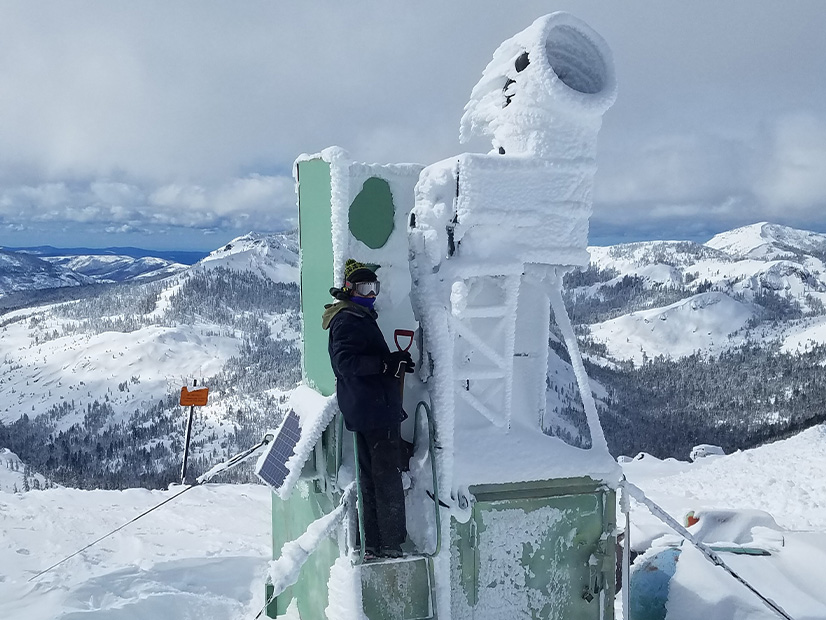
A California Energy Commission workshop this week looked at using cloud seeding to increase winter precipitation and snowpack as a way to boost late spring and summer runoff and hydropower, especially in the current drought.
“Those of us who are based in California are all too aware that the ongoing drought situation makes these issues particularly salient right now,” Susan Wilhelm, team leader for energy-related environmental research at the CEC, said Tuesday at the workshop. “While hydroelectric power is an important source of zero-carbon dispatchable power in our state, by late summer, hydropower resources are significantly diminished. This is especially so during drought conditions and has been especially so this year.”
Most of the state is in exceptional or extreme drought, according to the U.S. Drought Monitor. Major reservoirs behind hydroelectric dams stand far below their averages for November. Lake Shasta, the state’s largest reservoir, held 35% of its average content in mid-November and Lake Oroville held 58% of its average. The hydroelectric facility at Lake Oroville stopped producing power this summer for the first time since it opened in 1967 due to low water levels.
“There is a dire situation … [and] so cloud seeding is one of the viable alternatives to mitigate some of the adverse impacts of drought,” said Ramesh Gautam, manager of the snow survey program at the California Department of Water Resources. California and other Western states, including Arizona, Idaho and North Dakota, have been seeding clouds for decades, he said.
The Sacramento Municipal Utility District (SMUD) has been seeding clouds over the upper American River watershed southwest of Lake Tahoe since 1969 to increase hydropower production.
“To obtain this, we use glaciogenic seeding techniques, dispersing silver iodide particles when cloud conditions are ideal,” said Kaitlyn Bednar, SMUD hydrographer and cloud seeding project manager. The particles can be dispersed from ground units or airplanes, she said.
“Silver iodide is used as a cloud seeding agent because it has a crystalline structure similar to ice crystals,” she said. “It acts as an effective ice nucleus at around negative four degrees Celsius and lower. Once seeded, these newly formed ice crystals then continue to grow at a more rapid rate and fall out of suspension.”
Seeding clouds in the right conditions increases snowpack by roughly 3% to 10%, Bednar said.
“So, for example, in an average year if you get 50 inches of snow water equivalent, cloud seeding can increase that value up to 55 inches, translating to a large increase of runoff and power generation,” she said.
SMUD expanded its target area in 2017 from roughly 190 square miles to 444 square miles and seeds from November to March, Bednar said. Evaluations in 1975 and again in 2017 showed SMUD’s cloud-seeding has had insignificant environmental effects, if any, she said.
Pacific Gas and Electric, the state’s largest utility, has been seeding clouds in the Sierra Nevada since 1952. It halted one longtime effort over Lake Almanor, in the Sierra Nevada foothills, due to push-back from residents concerned about toxins. But PG&E continues to seed the Mokelumne River watershed in the mountains southeast of Sacramento, as it has been doing for 70 years.
“The Mokelumne cloud-seeding project is one of the oldest continuous cloud-seeding projects in the world,” said Kenneth Ericsson, a PG&E meteorologist who works in the utility’s cloud-seeding program.
PG&E uses ground-based burners to send silver iodide particles into cold, water-laden clouds, resulting in precipitation increases of 6% to 15%, Ericsson said.
“With a 6% increase, this can add approximately 8,700 acre-feet of water per year over the long term for the Mokelumne project,” he said.
PG&E has been studying a proposal to seed clouds in the watersheds of the Pit and McCloud rivers near Mount Shasta in an area with 7 million-acre feet of natural underground aquifer storage, Ericsson said. Lake Shasta holds about 4.5 million acre-feet in comparison.
During severe or prolonged droughts, the aquifer could produce about 10% of usable water in California, he said. A 5% increase in precipitation from cloud seeding could add approximately 210,00 acre-feet of water per year to the aquifer, rivers and Lake Shasta, increasing hydropower production, he said.
Does It Work?
The efficacy of cloud seeding has been debated for decades, with increases in precipitation difficult to measure scientifically or with statistical accuracy.
Sarah Tessendorf, a project scientist with the National Center for Atmospheric Research in Boulder, Colo., said supercomputing advances have allowed the “development of a new cloud seeding modeling capability that simulates the physics of cloud seeding.” Radar tracking and snow-gauge measurements have correlated with the computer predictions, Tessendorf said.
“One of the benefits of running the model is we can have a controlled experiment where we can see it in a simulation, and we can run the same simulation without seeding and look at the differences,” she said. “Something that we’ve been struggling with for decades is to have a truly controlled experiment in order to quantify the impacts of cloud seeding, so this modeling capability really moves us forward in that regard.”
In Idaho, an airplane distributed silver iodide while flying a zig-zag pattern. It resulted in precipitation falling in the same distinctive pattern, she said.
Frank McDonough, a former NASA scientist who heads the cloud-seeding program for the Desert Research Institute in Reno, Nev., said human air pollution has lessened rainfall and snowfall, making it more difficult to determine if cloud seeding works.
“Potentially, the challenge of finding the cloud-seeding signature is we’re seeding in a time when precipitation efficiencies are decreasing,” McDonough said. “So what we might actually be doing is keeping the storms the way they were by doing the cloud seeding.”
Additional comments and materials can be found on the CEC’s website at docket 19-ERDD-01. The CEC said it would eventually post a recording of the workshop but had not done so as of Thursday afternoon.
